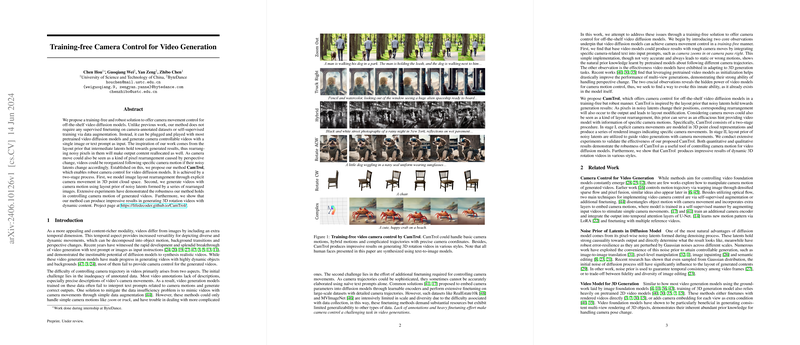The topic of "Training-free Camera Control for Video Generation" is addressed through advancements in video diffusion models and control mechanisms that allow for precise manipulation of camera movements without the need for extensive training data or finetuning. Two significant papers that contribute to this field are especially notable.
The paper "Training-free Camera Control for Video Generation" proposes a novel method called CamTrol, which offers a robust solution for controlling camera movements in video diffusion models without requiring supervised finetuning on camera-annotated datasets or self-supervised training. CamTrol leverages the concept of layout priors inherent in the intermediate latents of diffusion models. By rearranging noisy pixels, the model achieves video reorganization following specific camera motions. This process is implemented in two stages: first, modeling image layout rearrangement through explicit camera movement in 3D point cloud space, and second, generating videos with camera motion using the layout priors formed by a series of rearranged images. Extensive experiments demonstrate the method's robustness and its capability to generate impressive 3D rotation videos with dynamic content (Hou et al., 14 Jun 2024 ).
Another prominent work is "ControlVideo: Training-free Controllable Text-to-Video Generation," which addresses the challenges in text-driven video generation, such as appearance inconsistency and structural flickers in long videos. ControlVideo adapts from ControlNet and introduces modules for cross-frame interaction in self-attention to ensure appearance coherence, frame interpolation to smooth flicker effects, and a hierarchical sampler to generate long videos efficiently. These modules collectively enable natural and efficient text-to-video generation without the need for additional training, facilitating control over the camera and motion aspects of generated videos (Zhang et al., 2023 ).
Together, these works underscore the potential of training-free approaches in enabling more flexible, efficient, and effective control over camera movement in video generation. They highlight how leveraging existing structures within diffusion models can lead to significant advancements without the heavy computational and data burdens typically associated with training models for such tasks.
